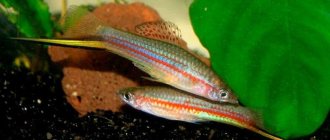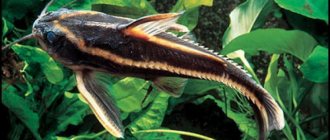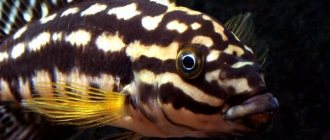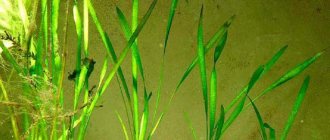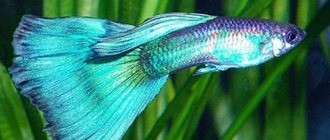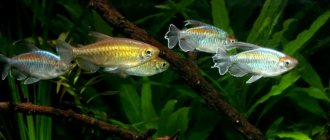Clarius catfish (or as it is also called, clarius catfish, clarias or African catfish) is an excellent aquarium cleaner, which is why it has gained its distribution and popularity. However, such fish grow quite quickly and have an unfriendly character towards their neighbors. For this reason, before you get a clariid catfish, you first need to learn more about the behavior of the fish, how to keep and breed it.
Habitat in nature
The African catfish lives in Asia and Africa, and can also be found in India, Laos, Indonesia, Cameroon, Bangladesh, Thailand and Vietnam. Fish prefer to live in those rivers that constantly maintain a warm water temperature, and therefore they do not cool down or freeze in winter. If the river cools and its temperature drops below 15°, the catfish will die.
If the rivers dry up, the clary catfish moves overland to a new habitat. And during the rainy season, the fish very quickly crawls into a new river. Cases of such movements have been recorded over distances of up to 4-5 km. It is because of this feature that the fish received another name - walking or walking catfish.
Breeding
In nature, the clary catfish breeds during periods of high water during the rainy seasons, and chooses lowlands and flooded floodplains for spawning.
There is no natural factor in the artificial environment, so farmers use hormonal stimulation, for example, with Ovaprim, Dosa, Human Chorionic Gonadotropin, the pituitary gland of brood catfish, carp, tilapia and frogs.
In order to create a high-quality broodstock, the healthiest and strongest Clarias are selected and placed in an area with enhanced nutrition. After stimulation, the temperature is raised above +18 °C. Females prepare a kind of nest in thickets of aquatic plants, and lay eggs there.
If farmers want to collect eggs, they create imitation nests artificially. She is fertilized with the milk of males and transferred to special aquarium incubators.
If fertilization occurs naturally, the eggs are not removed. The males fertilize it themselves and remain on duty at the clutches until the fry hatch.
Baby catfish, immediately after they have absorbed the yolk sac, begin to be fed with a mixture of cattle brains and egg yolk; after 5 days, the juveniles are transferred to another area, fertilized with bird manure and populated with zooplankton.
On small farms, juveniles may be fed mixed feed.
After a month, the young animals are sorted, those individuals who have gained 5-8 grams are transferred to intensive fattening, the norm for this period is 10 grams.
Some African farms are now producing genetically modified individuals for the tribe. The success of fish farming depends on the quality of breeding stock.
External characteristics
In proper habitat conditions, such a fish can grow up to 1 meter. The catfish is a lungfish: it has gills, with which it absorbs oxygen dissolved in water, and epibranchial lungs, with which it absorbs atmospheric air. It is completely covered with mucus, due to this it does not scratch its skin on land. However, it is dangerous for people because it can cause an allergic reaction.
The body of the fish is eel-shaped, elongated. The dorsal fin runs along the caudal peduncle and torso - it is necessary for vertical stabilization, as well as for protection from larger predators, so the fin contains about 60-75 feathers, on which there are poisonous secretions. In addition, the fish has anal and pectoral fins - the first is studded with feathers in the amount of 40-60 pieces, and the second - with powerful spines (when interacting with a person, they cause a rather unpleasant wound, which can be compared in sensations to a wasp sting).
A special feature of the fish is its mustache-tentacles, which are located on the upper and lower lips, 4 pieces each. They are used for navigation in muddy or dark water, as well as for luring food. The catfish has round eyes and a large mouth. Its skin is not covered with scales, so it is quite thick and smooth. It has a brown color with a shade of gray.
The behavior of the clarium catfish is rather inhospitable: it is constantly hungry, has a complex character, and enters into battle with fish of other species. It is more active at night and spends the day in shelter. He likes to dig up the soil, which causes damage to plants and equipment.
Species of Clarius catfish
There are about 61 species of fish in the genus Clariidae. However, the most common are:
- Clarius of the Nile. It is also called marble or African. Lives in South and Asia Minor, Africa. In its natural environment, the fish reaches a length of 170 cm and weighs about 60 kg. It takes on the color of water. There are black spots on the surface of the skin. Lives from 8 to 10 years.
- Angolan. Or in another way: spotted, sharmut, karmut. Migrated from Africa to South Asia. It grows up to 50 cm in length in the natural environment, and up to 35 cm in an aquarium. Weight approximately 1-1.3 kg. The main color of the abdomen and the entire body is white or milky, sprinkled with black or brown spots.
- Frog. Or Clarius batrachus (commercial catfish). It lives in the South Asian region, but is of African origin. The weight and size of the fish coincides with the parameters of the Angolan Clarias. The fish has a rather unusual color: the belly is light, the sides are olive-colored, and the back is painted black.
Description
This individual belongs to the Clariidae family. It is often confused with the sacbranch catfish. The external resemblance is truly striking. Both fish can go without water for a long time. There are known cases when clarius, in their travels between bodies of water, covered up to five km of land. They can be distinguished by the dorsal fin (in Clarius it is longer) and by the structure of the respiratory organs.
Adults living in an aquarium grow up to 70 cm. The body is elongated, snake-like, abundantly covered with mucus. There are no scales. There are 4 pairs of long antennae on the head. The pectoral fins are equipped with spine-like processes, which can be pricked quite sensitively. The dorsal and anal fins are elongated, the tail is short.
The color is muted, from gray-brown to olive. There are also other varieties - spotted form and albino (golden).
Determining the sex of Clarius is quite problematic, but if you look carefully, the following differences can be noted: females are more well-fed. In males, the tips of the dorsal fin are colored darker in places; the second feature is a wide, even massive, forehead.
Recent research by scientists has brought an interesting discovery. It turns out that Clarius can distinguish colors. Why nature endowed catfish with this unusual ability for fish is unknown. After all, they live in the dark.
Natural habitat is the tropical regions of Africa and southeast Asia. For some time now, it can be found in water bodies of the USA, where Clarius was brought for breeding, but the breeders made a huge mistake. In America, Clarius had no natural competitors or enemies. After some time, the predator multiplied and began to pose a serious threat to local fish species. The only limiting factor was unsuitable climatic conditions. This individual does not tolerate cold at all and is not able to survive the winter.
Maintenance and care
Maintaining and caring for an aquarium clariid catfish involves completing the following points for arranging its new habitat (this information will be especially useful for novice aquarists):
- The size of the aquarium should be such that the fish feel comfortable and have plenty of space. Therefore, young fish should be placed in an aquarium with a volume of about 150 liters, and adults in a tank of at least 300 liters. There must be a lid on top of the tank to prevent the catfish from getting out.
- Water parameters - acidity should be in the range of 5.5-8 pH, hardness up to 30 dH, and temperature - 20-30 ° C. It is necessary to replace the water every week, since it is important for catfish to be in clean and fresh water.
- Soil – despite the fact that aquarium catfish thrive in gravel, artificial rocks or sand, it is recommended to take small pebbles or sand as soil, since stones with sharp edges can break the glass of the tank when an adult starts throwing them.
- Plants - not a single plant will stay in the same aquarium with a catfish for a long time, so it is better not to start planting them.
- Lighting – standard lighting is quite suitable for catfish.
- Aeration and filtration – the water must be well oxygenated and clean, so it is important to install a powerful filter and replace the liquid regularly.
Adviсe
- It does not tear the roots of plants in pots, but chews leaves. Not all varieties of greens are suitable.
- A catfish accustomed to dry food does not eat its neighbors.
Clarias catfish is an active fish, 0.3–1 m in size. Aquarium from 150 liters. With filtration and aeration. With or without rocky soil. Predator. Does not get along well with other species. Unpretentious in content. Omnivorous. Lives 8–20 years.
Previous
FishFeatures of reproduction and childbirth of a pregnant female swordtail
Next
Fish Tips for keeping a large cleaner - brocade catfish!
Feeding catfish
Catfish loves to eat quite well, so almost all the time he feels hungry. Due to these characteristics of the fish, it needs to be fed several times a day. He eats everything, so you can use any of the available types of food to feed him (everyone here is guided by its price): tablets, fresh, dry or frozen.
The main food products are:
- Squid pieces;
- Shellfish;
- Chicken liver;
- Beef heart;
- Tubifex;
- Worms;
- Other fish;
- Bloodworm.
Be sure to include plant-based foods in your diet. The African catfish eats most of its food in the evening and at night. However, feeding fish with poultry and pig meat is strictly prohibited, since the proteins of these types of meat are not absorbed by the digestive system, but only contribute to the occurrence of obesity.
Compatibility with other fish
Clarium catfish are fish with a rather complex character that prefer to live alone. Sometimes Pisces can form strong couples: then they will spend all their time together with their significant other, tenderly caring for each other. However, if you add other species of fish to the catfish, it will not get along with them, since it constantly attacks its neighbors and starts fights, in which, as a rule, it wins.
For this reason, it is possible to keep clarius without possible danger to the lives of other inhabitants only with larger fish: armored catfish, bream barbs, pacu and astronotus. It is strictly forbidden to introduce small fish to catfish, otherwise he will simply eat them.
Reviews
Claims:
- It is impossible to feed enough.
- The amount of food does not matter; it will snack on its aquarium mates.
- He arranges the premises himself. It makes noise at night.
- Doesn't get along well with plants. He even eats shellfish with the shell.
- Jumps out of the aquarium.
What they value:
- Individual character. There are non-aggressive individuals suitable for a community aquarium.
- When kept separately, it becomes attached to the owner. He will find out. Allows you to pet it. Playing. Tries not to hurt. He is wary of strangers.
- Omnivorous. Does not require separate food.
Fish reproduction
Breeding clarius at home is extremely rare, since the fish need a lot of space to produce offspring. Spawning in catfish begins when they reach maturity. Having formed a pair, the fish spend all their time together, showing signs of attention. In order for reproduction to begin, algae should be planted in the aquarium and shelters should be placed (so that the female lays eggs in one of them). During one clutch, the female produces about 300-600 eggs.
The offspring appear after 48 hours. Both the male and the female protect and care for the fry. After 6 days, the babies begin to feed independently and actively swim. At this time, parents should be removed from them. The fry must eat microfood, the serving size of which increases as the fish grow. In addition, catfish should be sorted by size - this is done so that large catfish do not offend smaller ones. When the fish are 1.5 months old, their epibranchial organ will begin to form.
Often owners of clariid catfish are interested in the question of how long they live. With proper care and attention, Clarius will live about 8-10 years.
Diseases and their prevention
Like any fish, Clarias catfish is susceptible to various fungal, bacterial and parasitic diseases. The most common among them:
- Head deformation. Symptoms of this disease include deformation of the fish skeleton. She suddenly stops eating, and the tissues on both sides of her head swell. To get rid of the disease, it is worth providing a sufficient amount of vitamin C in the food.
- Broken bowel syndrome. It is characterized by a swollen abdomen, loss of color of the abdominal part, and redness of the anal area. To avoid disease, it is worth giving well-digestible and balanced food.
- Peptic ulcer disease. It manifests itself by the appearance of ulcers on the skin, the fish becomes lethargic, white and red ulcers appear on the surface of the upper and lower jaw, as well as on the caudal fin. To get rid of the disease, it is worth monitoring the water quality in the aquarium.
- White spot disease. Symptoms: the fish swims sluggishly, is in an upright position at the surface of the water, and white spots appear around the gills and mouth. To prevent the disease, antibiotics (oxytetracycline, terramycin or chloramphenicol) should be added to the feed.
Interesting Facts
- Clarias catfish generates electricity with an organ specially designed for this purpose. Using electrical discharges, this predator communicates with relatives.
- During sleep, the catfish stands strictly vertically - on its tail or with its face down.
- Clarias quickly gets used to his owner and allows himself to be petted.
- The skin of the fish produces a protective mucus that has healing properties. It quickly heals any wounds.
- Clarius meat is considered a healthy dietary product. It does not have an unpleasant specific fishy smell, small bones or fat, and contains a huge amount of amino acids and vitamins.
